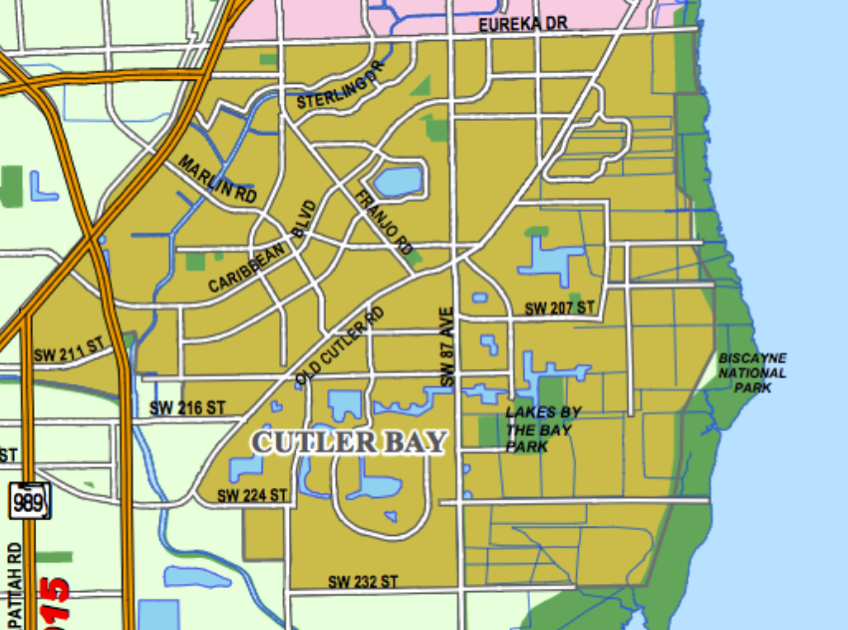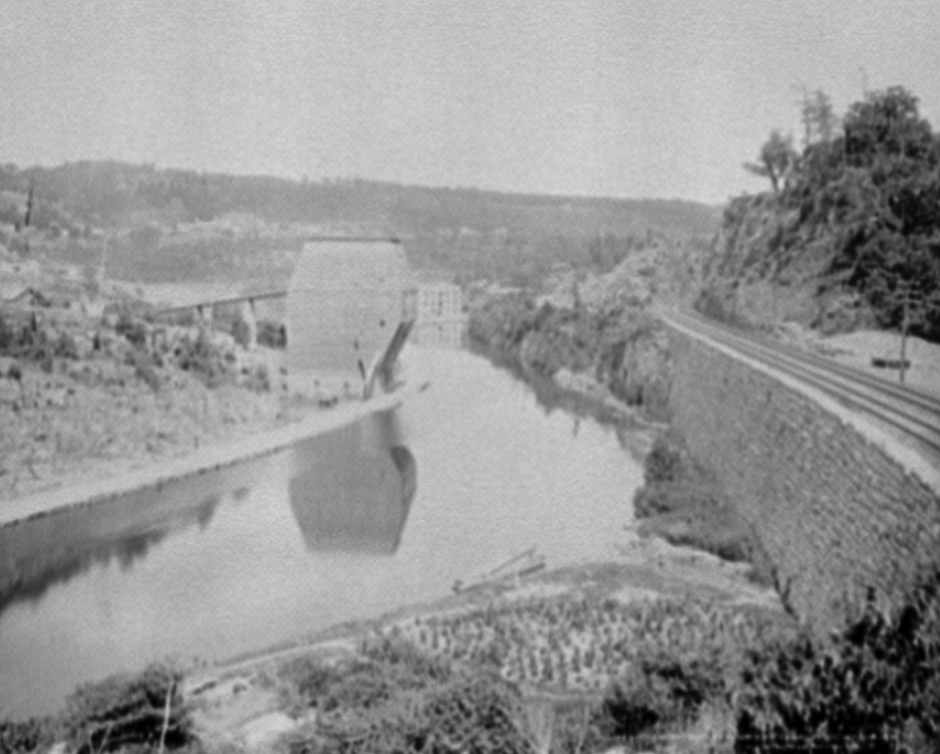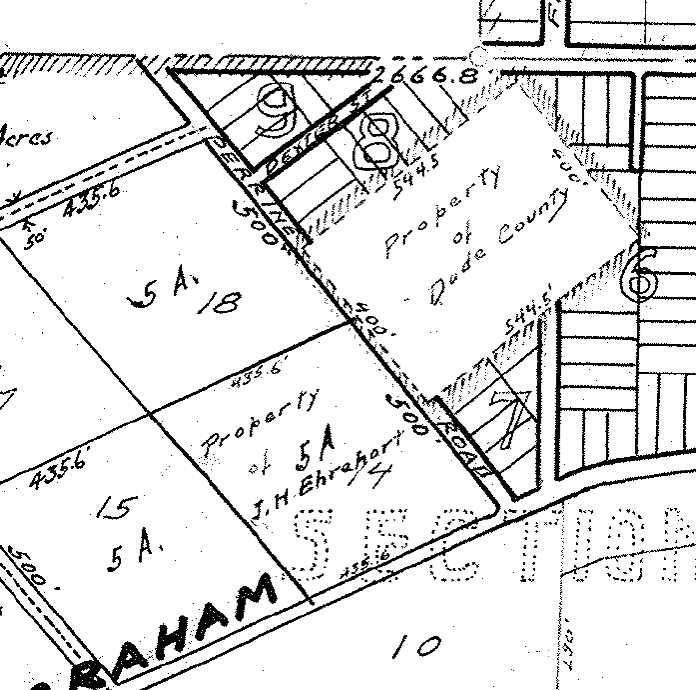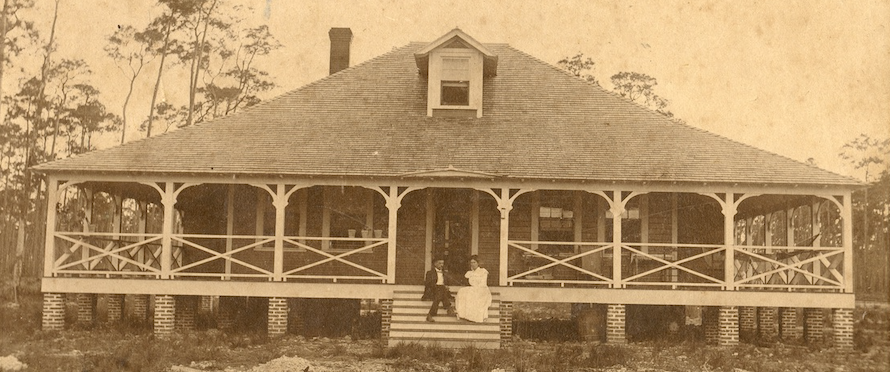The Story of Franjo Road
By Jeff Blakley
I wrote my article about Baile’s Road, which I had always been curious about, because it did not follow the rectangular grid of Dade County’s streets and avenues. There is another road in South Dade which does not follow that rectangular grid either: Franjo Road. The story begins with John Hill Ehrehart, a man who came from a family of modest means but accumulated a fortune and moved in high-society circles. After his death, he sank into obscurity. He was well-travelled, having spent time in Colorado, New Mexico, Georgia, North Carolina and Florida. Most of his life was lived in New York City and small towns in the northern part of the state but he had large real estate holdings in the last three states.

John was born on May 24, 1856 in Hughesville, Lycoming County, Pennsylvania,1 the first child of the Rev. Charles John Ehrehart and his wife, Martha Elizabeth Hill.2 His father was a well-to-do Lutheran minister with real estate valued at $8,000 and a personal estate of $2,000 in 1870.3 Charles graduated from Pennsylvania College in 18504 and from the Gettysburg Seminary in 1852,5 was one of the founders of the Shamokin Institute, a public school in Coal Township, Northumberland County, Pennsylvania and the principal of the preparatory department of Pennsylvania College, a Lutheran school, from 1865-1870.6 It was renamed Gettysburg College in 1921.
Ehrehart graduated with a civil engineering degree from Pennsylvania College in 1874.7 His first job was as a locating engineer on the portion of the Atchison, Topeka and Santa Fe Railway that passes through Pueblo, Colorado. In 1880, he was in Little Falls, Herkimer County, New York, where he worked on the New York, West Shore and Buffalo Railway, then being built there.8

John H. Ehrehart met his wife, the former Frances L. Weeks, in Little Falls and they were married on her birthday, May 24, in 1883.9 She was the daughter of William H. Weeks, a leather merchant.10
The New York, West Shore and Buffalo Railway, a competitor of the New York Central Railroad (NYC), owned by William H. Vanderbilt, was forced into bankruptcy in a rate-war initiated by the NYC and then purchased by them in 1885.11
John and his wife disappeared from the documentary record after he spent 1888 – 1889 in Utica, NY as a civil engineer and surveyor.12 In 1897, he was an employee of the New York Central and argued for a lower assessment of the company’s properties in the Rochester area13 and in 1900, he argued for lower corporate franchise taxes in Buffalo, where he stayed at the Iroquois Hotel.14 From 1901 to 1905, he worked for the State of New York in the Tax Commissioner’s office in Albany.15 He and his wife then moved to Horseshoe, in the Adirondacks, which was founded by Abbot Augustus Low. That is a fascinating story to read. The Ehreharts were still in the area in 1910, when they were enumerated in the little town of Piercefield, not far from Horseshoe Lake.16 The Adirondacks were served by the New York Central, which employed Ehrehart.
As early as 1908, the Ehreharts made the Hotel Marie Antoinette in New York City their home. The New York Sun reported in that year that Mrs. Ehrehart owned “a camp on Pleasant Lake in the Adirondacks that was threatened by a forest fire.”17
John and Francis first came to Miami and stayed at the Royal Palm Hotel during the winter of 1904-1905.18 The Royal Palm was the place to see and be seen in Miami. The Ehreharts, who stayed at there every winter from 1904 until 1926, when it was badly damaged by the hurricane of that year, made the acquaintance of many rich and powerful people. John, whose first job was with the Atcheson, Topeka & Santa Fe Railway Co., may have come to Miami due to his friendship with Col. Henry R. Duval, who was a director of that railroad.19 Duval owned a considerable amount of land in the Cutler area.
In September of 1905, Ehrehart purchased 240 acres from Carrie Root for $1,200 in section 9, township 56, range 40 east.20
In May of 1906, he purchased 800 more acres but we don’t have a legal description for that purchase. It most likely adjoined his existing holdings.21 In July, Ehrehart bought another 80 acres, this time for $1,500, more than what he had paid for 240 acres less than a year before. This land was sold to him by Frank A. Root (Carrie’s husband and a well-known boat-builder in Miami) and it was the N 1/2 of the NE 1/4 of 10-56-40.22 There are no more mentions of land purchased by him, but by September of 1907, when Miss Frances Young married Wilfred B. Focht, Ehrehart had accumulated almost 2,000 acres,23 most of it purchased through the agency of Dr. Samuel H. Richmond.24 25

Ehrehart built a home on his property and named it “Franjo” before 1907, when the newly married Wilber B. Focht and Frances A. Young stayed at his home for a few days after their wedding. The name was likely a contraction of the first names of Frances L. Ehrehart and her husband, John.
Because John was so well-connected in the railroad world, he no doubt made many trips to the Keys on the Oversea Railroad. In 1909, he and his wife returned to Miami from one of those trips.26
The first mention of what is now known as Franjo Road was in 1911, when “a fine rock road to Perrine” was being built to “bring the products from the farm much nearer transportation facilities.”27
That rock road is identified as the “Perrine Road” on the 1924 plat of Tenalla Ocean Farms, recorded in book 8 on page 124 of the Miami-Dade County records. The plat shows the property of J. H. Ehrehart at the northwest corner of what is now Old Cutler and Franjo Road, across the road from Franjo Park, which is the property shown on the plat as belonging to Dade County.

In April of 1912, the newspaper reported that “J. D. Brown,28 one of Cutler’s enterprising growers” had “charge of the 400-acre plantation of J. H. Ehrhart, a wealthy New York investor.”29
Brown was in charge of Ehrehart’s plantation in South Dade and also managed his “large peach orchard” in Georgia.30 In 1917, Ehrehart offered his “summer home in Mt. Airy with 6 acres of land, two orchards with 20,000 peach trees and 1,200 apple trees at Cornelia and Mt. Airy, GA for $28,000.31 He also owned 800 acres of peach orchards in Pinehurst, North Carolina which he had accumulated between 1915 and 1920.32 When he and his wife retired to Miami in the early 1920s, he continued buying and selling real estate.33
In 1924, The Miami News noted that Ehrehart had sold 1,000 acres to the the Tenalla Ocean Farms Corp. for $89,000.34 The Tenalla Ocean Farms Corporation was incorporated in early 1924 by Arthur J. Gannon, an architect and builder in Miami and Dexter E. Richards, the former owner of the Bell Coal Company in Cincinnati, Ohio and a principal in the investment banking firm of Field, Richards & Co. in that city. Dexter’s first wife, Emma, who had died in 1923, was a sister of Reamy E. Field, the other principal of the company. John retained the 5 acres where his house was located, as shown on the plat. There was an initial burst of land sales in Tenalla Ocean Farms, but by the late 1920s, the Tenalla Ocean Farms Co. joined a long list of speculative real estate ventures that had failed as a result of the bursting of the real estate speculation bubble that had started in 1896.
The 1930 U. S. census enumerated residents living on the Perrine Road.35 The name was changed to Franjo Road some time before early 1940, when C. M. Seifert built a house on the road.36 In 1933, Dade County beautified the road by planting 450 Canary Island date palms on either side of the road. The palms were donated by Dr. William S. Burkhart and the project only cost the County “$600, because of Dr. Burkhart’s tree gifts and the use of convict labor for most of the work.”37 Burkhart and his son-in-law owned thousands of acres of land immediately south of Ehrehart’s holdings in sections 9, 16 and 17.38
There are no known photographs of the Ehrehart house but one might turn up in the future. A farming community known as Franjo Farms existed in the area but no research has ever been done about the people who lived and worked there. The Town of Tenalla was never built and part of the Tenalla Ocean Farms property was later acquired by August Burrichter,39 a potato farmer who owned land in the northern East Glade. G. Walter Peterson, a prominent potato grower in Goulds, also purchased some of Burkhart’s land and later sold it to the developers of Saga Bay.40
Ehrehart’s wife Frances died at a Fort Dallas apartment house on May 18, 192941 and John died at his home at 1020 N.W. 5th Avenue on December 17, 1934.42 They are likely buried in Little Falls, New York.
Like many other wealthy people, the Ehreharts came to South Florida and became well-known and respected. When they died with no one to carry on their name, their only legacy became the name Franjo attached to a minor road in South Dade. They were not from Florida and are not buried here. No building is named after them and no one today, if asked, would be able to answer why Franjo Rd. is so named.
It is a real tragedy that the history of South Dade has been so ignored. If it hadn’t been, perhaps the town of Cutler Bay would be known as Tenalla or Franjo instead.
_____________________________________________________________________
Originally posted on May 26, 2018. Completely rewritten on November 28, 2023.
- The Pennsylvania College Book, 1832-1882, E. S. Breidenbaugh, Editor, Philadelphia, Lutheran Publication Society, 1882, p. 331
- Personal communication, Stephen Staruch, an Ehrehart family genealogist
- 1870 census of Gettysburg, Adams, PA for John Hill Ehrehart, b. 1856
- Annual Catalogue of the Officers and Students in Pennsylvania College, Gettysburg, Adams Co, Pa., 1850, printed by H. C. Neinstedt, 1850, p. 9
- Catalogue and Constitution of the Theological Seminary of the General Synod of the Evangelical Lutheran Church in the United States, J. E. Wible, printer, Gettysburg, 1867, p. 14
- Catalogue of Pennsylvania College, 1868-1869, Philadelphia, Jas. B. Rodgers Co., printers, 1869, p. 28
- The Pennsylvania College Book, 1832-1882, E. S. Breidenbaugh, Editor, Philadelphia, Lutheran Publication Society, 1882, p. 330
- Obituary for John H. Ehrehart, Miami Daily News, December 21, 1934, p. 15
- Genealogy of the Family of George Weekes of Dorchester, Mass., 1635=1650, by Robert D. Weeks, 1885. Press of L. J. Hardham, Newark, NJ, p. 204
- 1865 New York census of Little Falls, NY
- Ibid.
- City directories of Utica, available on Ancestry.com
- The Buffalo News, August 20, 1897, p. 4
- The Buffalo News, March 20, 1900, p. 1
- City directories available on Ancestry.com
- U. S. census, 1910, for John H. Ehrehart, b. 1856 in PA
- The Sun, October 23, 1908.
- Miami Herald, Dec. 4, 1926, p. 18
- Miami Herald, March 19, 1924, p. 19
- Miami Metropolis, September 27, 1905, p. 5. This was the N 1/2 of the NE 1/4 (80 acres) and the SE 1/4 (160 acres) of 9-56-40. The N 1/2 of the NE 1/4 of 9-56-40 is bounded by SW 200th St. on the north and SW 87th Ave. on the east. Franjo Park is located within the N 1/2 of the NE 1/4. The SE 1/4 of 9-56-40 is bounded by SW 216 St. on the south and SW 87th Ave. on the east. It lies east of Old Cutler Rd.
- The Miami Metropolis, May 25, 1906, p. 6
- Miami Evening Record, July 7, 1906, p. 5
- The Miami Metropolis reported on January 21, 1911, p. 1 that he was “the owner of seventeen hundred acres at ‘Black Point’, a fertile tract of red land on the bay shore south of Cutler.”
- Miami Metropolis, May 11, 1907, p. 11. Wilfred B. Focht was the son of Rev. John B. Focht, D.D., of Plainfield, CT and his bride Frances was the daughter of James Henry Young and Abbie Ann Gregg.
- Young owned one of the first sawmills in the Cutler area. Interestingly enough, two of the attendees at the wedding, Mr. and Mrs. Samuel Stauffer, were from Selinsgrove, PA, which was near where John H. Ehrehart was born and raised.
- Miami Metropolis, January 15, 1909, p. 3
- Miami Metropolis, January 21, 1911, p. 2
- J. D. Brown, the father of J. B. and Claude, died in 1888. The writer of this article heard “D” instead of “B” when speaking to James Bedell Brown (1876-1951). His sister, Mary Alice, was the wife of Edgar C. Gaunt, who was a very early arrival in Miami.
- Miami Metropolis, April 13, 1912, p. 2
- Ibid
- Atlanta Journal, Feb. 4, 1917, p. 18. Mt. Airy and Cornelia are both in Habersham County, GA, about 60 miles northeast of Atlanta
- Items in the The Pinehurst Outlook from March 20, 1915 to January 28, 1920
- Items in the Miami Herald, the Miami Daily Metropolis and the Miami Tribune from January 19, 1921 to April 12, 1925
- Miami News-Metropolis, March 8, 1924, p. 15
- 1930 census of Precinct 67, Dade, Florida, p. 12-B, lines 80-100
- Redland District News, February 23, 1940, p. 6
- The Miami Daily News, June 11, 1933, p. 2
- Delinquent tax list, Miami Daily News, July 1, 1929, p. 21
- Re-plat of Tenalla Ocean Farms, plat book 49, page 38
- Personal conversation with Peterson’s daughter, Ann Maree.
- Miami News and Metropolis, May 18, 1929, p. 10
- Miami Daily News, December 17, 1934, p. 15

My Uncle John Hollis Steele was General Manager of Tropical Agriculture Corporation Association (TACA) Packing House in Goulds, FL. G. Walter Peterson was the owner, they planted; processed and shipped potatoes to all parts of the country by rail and trucks. My Uncle started out at 13 making and selling wooden boxes to them, then they hired him to make boxes for them full-time. Then he started overseeing the planting, growing, etc. and wound up being an investor and General Manager for over 40 years.
The name of the Goulds potato farmer who Hollis Steele worked for was Lou Peters, not G. Walter Peterson.
I lived on Franjo Rd. for 14 years – never knew this info. Thank you.
Fascinating stuff! Thanks again for your diligent research, Jeff.
Interesting and thank you.
Have you done any other research re: August Burrichter? When my father, A.E.C. McIntyre, and his partner J. Lee Smith Sr., started S&M Farm Supply c. 1956, I believe that some of their initial capital came from Mr. Burrichter (as a loan, I gather). Dad used to mention that Burrichter had been in the German navy during World War I, before emigrating to the States after the war. Never verified that, nor did I ever get to meet him when he lived in Homestead, on McMinn Road around SW 300th St., I think. Thanks for the work you’re doing in preserving South Dade history.
Another very good article on the history of South Dade, Jeff. I appreciate your diligence in the articles you write. I never knew the history of Franjo Road.
I think the Bel-Aire subdivision, when it was developed, adjoined or had an outlet onto Franjo Road. It became a short cut to Perrine.